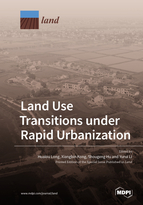Land Use Transitions under Rapid Urbanization
A special issue of Land (ISSN 2073-445X).
Deadline for manuscript submissions: closed (1 July 2021) | Viewed by 102727
Special Issue Editors
Interests: land-use transition; land consolidation; sustainable land management; rural restructuring; urban-rural integrated development; rural geography
Special Issues, Collections and Topics in MDPI journals
Interests: arable land quality; LUCC; land ecology
Special Issues, Collections and Topics in MDPI journals
Interests: land use transition; urban-rural development; land space optimization; cultivated land protection; natural resource utilization policy; spatial analysis and modeling
Interests: land use; land consolidation; land governance; community development; rural development; regional development; human geography
Special Issues, Collections and Topics in MDPI journals
Special Issue Information
Dear Colleagues,
Land use transition is a manifestation of land use and land cover change (LUCC), and is also a major research focus of the Global Land Project (GLP) as well as land system science (LSS). Land provides essential resources to society and its changes have large consequences for the local and global environment and human well-being. The past, current, and projected state and dynamics of land use is the major content of land use science, which is influenced by long-term anthropogenic changes. The concept of land use transition highlights that land use change demonstrates a non-linear process and is related to other societal and biophysical disturbances through a series of transitions.
Land use transitions can be seen as primary forces driving the transformation of the rural-urban territorial system, and bring about direct socio-economic and environmental effects on regional sustainability, e.g., resulting in farmland loss and soil degradation, affecting biodiversity and the ability of ecosystems to serve human needs, polluting the rural environment, influencing agricultural production and food security, and causing regional socio-economic and spatial restructuring. Land use transitions can be measured by changes in both the dominant morphology (e.g., quantity, structure, and spatial pattern) and recessive morphology (e.g., quality, property rights, management mode, fixed input, productive ability, and function) of land use.
We invite papers that detect or examine the process, pattern, and socio-economic and environmental effects of land use transitions and the mechanism of human–land interactions against the context of rapid urbanization and industrialization from a wide range of perspectives (i.e., geographical, social-political, ecological, etc.) and provide solutions for sustainable land use based on scientific findings. Outcomes of your participation will enrich the land use research and promote academic exchange between different culturally heterogeneous regions.
Prof. Dr. Hualou Long
Prof. Dr. Xiangbin Kong
Prof. Dr. Shougeng Hu
Dr. Yurui Li
Guest Editors
Manuscript Submission Information
Manuscripts should be submitted online at www.mdpi.com by registering and logging in to this website. Once you are registered, click here to go to the submission form. Manuscripts can be submitted until the deadline. All submissions that pass pre-check are peer-reviewed. Accepted papers will be published continuously in the journal (as soon as accepted) and will be listed together on the special issue website. Research articles, review articles as well as short communications are invited. For planned papers, a title and short abstract (about 100 words) can be sent to the Editorial Office for announcement on this website.
Submitted manuscripts should not have been published previously, nor be under consideration for publication elsewhere (except conference proceedings papers). All manuscripts are thoroughly refereed through a single-blind peer-review process. A guide for authors and other relevant information for submission of manuscripts is available on the Instructions for Authors page. Land is an international peer-reviewed open access monthly journal published by MDPI.
Please visit the Instructions for Authors page before submitting a manuscript. The Article Processing Charge (APC) for publication in this open access journal is 2600 CHF (Swiss Francs). Submitted papers should be well formatted and use good English. Authors may use MDPI's English editing service prior to publication or during author revisions.
Related Special Issue
- Land Use Transitions and Land System Science in Land (8 articles)









